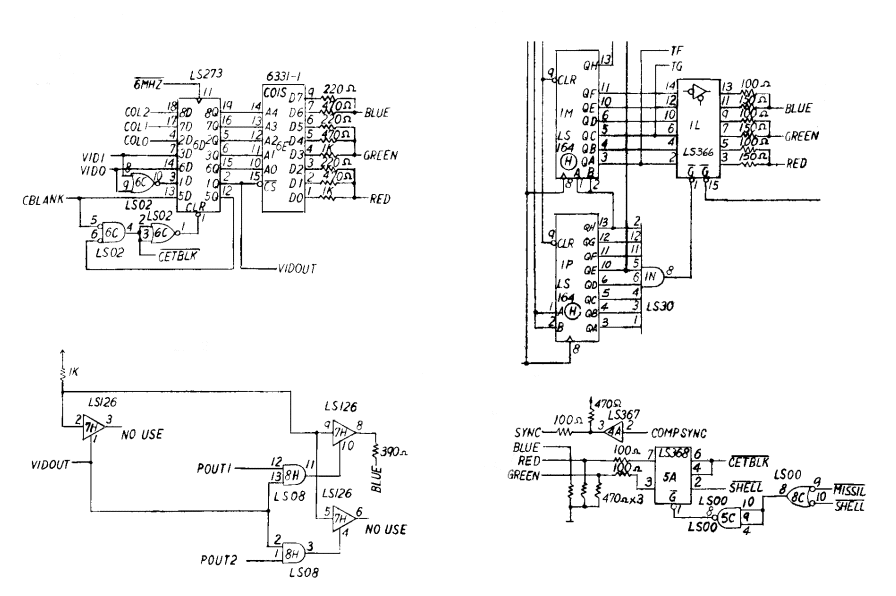I wrote the first FPGA Scramble/Frogger core way back in 2007 (when we were all a lot younger)….

It’s been ported to all sorts of other hardware with little changes, but when we were moving it to our new build system I took the opportunity to look at the video output stage again. Looking at the schematics pics below, Scramble has a simple resistor DAC (top left) for the character video, additional outputs for stars (top right), a blue background for Frogger (bottom left) and logic for Missiles and Shells (bottom right).
The designers cleverly used the CS (chip select) pin of the output look up table (6331-1) to disable the outputs when the video level (VID1 & VID0) is zero. When the chip is not driving, the ends of the resistor are floating and don’t mess up any of the other outputs. However some things are on together, for example the missiles over characters. Also, some games have minor differences – Frogger has 470R on “blue”, but Scramble has a 390R resistor fitted.
I learnt a trick from Chris Brenner who wrote a script which ran through every combination of the Pacman audio DAC in SPICE, evaluated the output voltage and built a look up table for the FPGA. SPICE is an open source circuit simulator which has been around since the dawn of time. https://en.wikipedia.org/wiki/SPICE

I wrote a simple script in Python using PySpice, which builds the above circuit in every combination, modelling board output resistor and monitor termination. https://pyspice.fabrice-salvaire.fr/
If I picked datasheet typical values of 0.35 VoL (low output voltage) and 3.3 VoH (high output) we got the interesting result that the “off” black is slightly lower than the driven zero black. My guess is with the original CRT the black level was adjusted so all off was super-black and you couldn’t see the difference. It looked a bit odd on a modern display where the black level is fixed. I slightly simplified the drive and built a LUT (look up table) that accurately recreates the colours of the original game.
This is all in our new replay_arcade github repository which will go live shortly.
Happy retro gaming.
/MikeJ
# -*- coding: utf-8 -*-
"""
Created on Wed Aug 28 11:08:18 2019
@author: Mike
"""
import PySpice.Logging.Logging as Logging
logger = Logging.setup_logging()
from PySpice.Spice.Netlist import Circuit, SubCircuit, SubCircuitFactory
from PySpice.Unit import *
# VoH typ is 3.4V
# VoL typ is 0.35V
# chars stars "blue"" shell/missile
#
# 220R B 100 B 470R B* 100R R
# 470R B 150 B 100R G
# 220R G 100 G
# 470R G 150 G
# 1K G 100 R
# 220R R 150 R
# 470R R
# 1K R
# 470R to 0V
# blue is 390 on scramble
# blue is driven with tristate, alway '1'. Only when vid = 0
# stars are tristate but with 0/1 input
# stars are disabled when video is non black. Checked rom 0 = 0
# video dac is disabled for vid = 0
# missle/shell is also tri, can go on top of anything
# old monitors had higher input termination, 300-1K. We'll use 470R
# 470/390 2/3 blue_on shell_level shell_on stars_on vid_on level3
def sim(vid_level, vid_has_0, vid_on, stars_level, stars_on, shell_level, shell_on, blue_390_on, blue_470_on) :
circuit = Circuit('DAC %u' % vid_level)
circuit.V('_VH', 'in_vh', circuit.gnd, 3.3@u_V)
circuit.V('_VL', 'in_vl', circuit.gnd, 0.25@u_V)
## video
if (vid_on) :
if (vid_level & 0x4) :
circuit.R('_Vid2', 'in_vh', 'out', 220@u_Ω)
else:
circuit.R('_Vid2', 'in_vl', 'out', 220@u_Ω)
if (vid_level & 0x2) :
circuit.R('_Vid1', 'in_vh', 'out', 470@u_Ω)
else:
circuit.R('_Vid1', 'in_vl', 'out', 470@u_Ω)
if (vid_has_0) :
if (vid_level & 0x1) :
circuit.R('_Vid0', 'in_vh', 'out', 1@u_kΩ)
else:
circuit.R('_Vid0', 'in_vl', 'out', 1@u_kΩ)
## stars
if (stars_on) :
if (stars_level & 0x2) :
circuit.R('_Star1', 'in_vh', 'out', 100@u_Ω)
else:
circuit.R('_Star1', 'in_vl', 'out', 100@u_Ω)
if (stars_level & 0x1) :
circuit.R('_Star0', 'in_vh', 'out', 150@u_Ω)
else:
circuit.R('_Star0', 'in_vl', 'out', 150@u_Ω)
## shell
if (shell_on):
if (shell_level & 0x1) :
circuit.R('_Shell0', 'in_vh', 'out', 100@u_Ω)
else:
circuit.R('_Shell0', 'in_vl', 'out', 100@u_Ω)
## "blue"
if (blue_390_on):
circuit.R('_Blue390', 'in_vh', 'out', 390@u_Ω)
if (blue_470_on):
circuit.R('_Blue470', 'in_vh', 'out', 470@u_Ω)
# board output res to gnd
circuit.R('_Load', 'out', circuit.gnd, 470@u_Ω)
# term
circuit.R('_TERM', 'out', circuit.gnd, 470@u_Ω)
#print(circuit)
simulator = circuit.simulator(temperature=25, nominal_temperature=25)
analysis = simulator.operating_point()
for node in analysis.nodes.values():
if (str(node) == 'out'):
#print('{}'.format(float(node)))
return float(node)
# Lowest level is with missile/shell/stars disabled
# note, the DAC essentially has two black levels
# if vid=0 the dac is off, so super black
# vid = 1/2/3 but one colour chanel from the prom could =0, so dac black > "off" black
min_val = sim(0, True, False, 0,False , 0, False, False, False)
print('min rg:',min_val)
# max shell on plus stars plus blue
max_val = sim(7, True, False, 3,True , 1, True, True, False)
print('max rg:',max_val)
# 2 chan dac (blue) i've added a slight gain so the white point matches the 3 chan
#dac2_gain = 1.056 # ideal
dac2_gain = 1.04
# dac3bit shell_ena shell_level level
# 5 4 3 2..0
# blue_470 blue_ena shell_ena shell_level star_ena level
# 6 5 4 3 2 1..0
f = open('scramble_lut_vid.hex', 'w')
print('vid on')
for i in range (0,64):
dac3bit = bool(i & 0x20)
shell_ena = bool(i & 0x10)
shell_level = bool(i & 0x08)
vid_level = i & 0x7
#print('{} {} {} {}'.format(dac3bit,shell_ena, shell_level, vid_level))
val = sim(vid_level, dac3bit, True, 0, False, shell_level, shell_ena , False, False)
lut = (val- min_val) / (max_val - min_val)
if (not dac3bit):
lut *= dac2_gain
lut_int = int(round(lut * 255))
print('level {:7b}, {:f} {}'.format(i, val,lut_int))
line = ('{:02X} \n'.format(lut_int))
f.write(line)
f.close()
f = open('scramble_lut_nvid.hex', 'w')
print('vid off')
for i in range (0,128):
blue_470_on = bool(i & 0x20) and bool(i & 0x40)
blue_390_on = bool(i & 0x20) and not bool(i & 0x40)
shell_ena = bool(i & 0x10)
shell_level = bool(i & 0x08)
star_ena = bool(i & 0x04)
star_level = i & 0x3
#print('{} {} {} {} {} {} {}'.format(i, blue_470_on,blue_390_on, shell_ena, shell_level, star_ena, star_level))
val = sim(0, False, False, star_level, star_ena, shell_level, shell_ena , blue_390_on, blue_470_on)
lut = (val- min_val) / (max_val - min_val)
if (not dac3bit):
lut *= dac2_gain
lut_int = int(round(lut * 255))
print('level {:7b}, {:f} {}'.format(i, val,lut_int))
line = ('{:02X} \n'.format(lut_int))
f.write(line)
f.close()